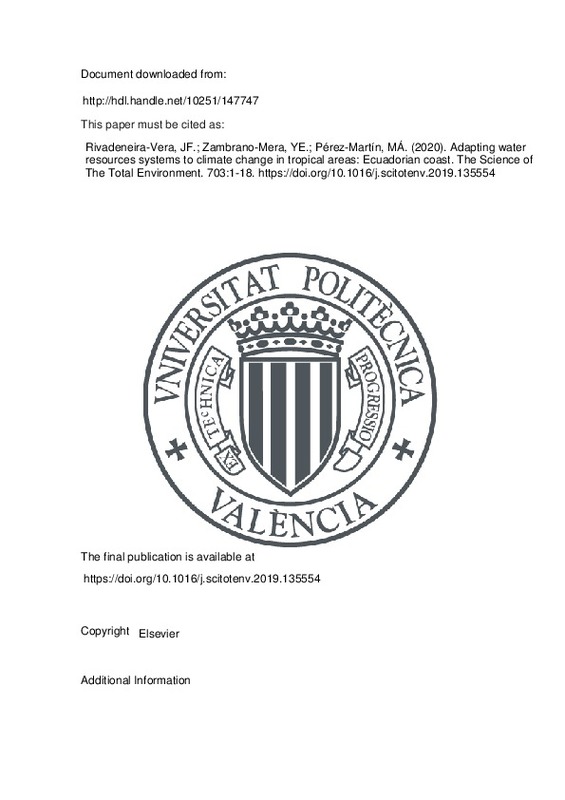|
Resumen:
|
[EN] Climate change is expected to increase rainfall and temperature in the tropical areas of the Ecuadorian coast. The increase in temperature will also increase evapotranspiration therefore, future water balance on ...[+]
[EN] Climate change is expected to increase rainfall and temperature in the tropical areas of the Ecuadorian coast. The increase in temperature will also increase evapotranspiration therefore, future water balance on Ecuadorian coast will have a slight variation. Changes in precipitation patterns and evapotranspiration will produce an increase in the water requirements for current crops, so an imbalance in the water resources systems between natural resources and water demands is expected. This study presents water resources management as an adaptation measure to climate change for reducing vulnerability in tropical areas.
Twelve bias-corrected climate projections are used, from: two AR5 General Circulation Models (GCMs), two Representative Concentration Pathways, 4.5¿8.5 scenarios, and three time periods, short-term (2010¿2039), medium-term (2040¿2069) and long-term (2070¿2099). These data were incorporated into the Lumped Témez Hydrological Model. Climate change scenarios predict for the long-term period both a mean rainfall and temperature increases up to 22%-2.8¿°C, respectively. Besides, the potential evapotranspiration will increase until 12% by Penman-Monteith method and 60% by Thornthwaite method. Therefore, natural water resources will finally have an increase of 19% [8¿30%]. Additionally, water requirements for crops will increase around 4% and 45%.
As this research shows, in tropical regions, currently viable water resources systems could become unsustainable under climate change scenarios. To guarantee the water supply in the future additional measures are required as reservoir operation rules and irrigation efficiency improvement of system from 0.43 to 0.65, which it involves improving the distribution and application system. In study area future irrigation areas have been estimated for 13,268¿ha, which under climate change scenarios is unsustainable, only 11,500¿ha could be expanded with a very high irrigation efficiency of 0.73. Therefore, in tropical areas the effect of climate change on expansion projects for irrigated areas should be considered to ensure the functioning systems.
[-]
|
|
Agradecimientos:
|
The authors thank the Secretariat of Higher Education, Science, Technology and Innovation of Ecuador (Secretaría de Educación Superior, Ciencia, Tecnología e Innovación, SENESCYT) for funding this research in the scholarship ...[+]
The authors thank the Secretariat of Higher Education, Science, Technology and Innovation of Ecuador (Secretaría de Educación Superior, Ciencia, Tecnología e Innovación, SENESCYT) for funding this research in the scholarship program: CONVOCATORIA ABIERTA 2011 (contract AR2Q-4308).
We would also like to express our gratitude to the National Institute of Meteorology and Hydrology (Instituto Nacional de Meteorología e Hidrología INAMHI), National Secretary of Water (Secretaría Nacional del Agua SENAGUA) and Geographic Military Institute (Instituto Geográfico Militar IGM) of Ecuador for providing data to develop this study.
[-]
|







![[Cerrado]](/themes/UPV/images/candado.png)


